A-shares staged a “red envelope” market before the Spring Festival, closing in the sun for 2 consecutive days, and the Year of the Rabbit will take advantage of the momentum?
sort out the pastThe trend of A-shares after the 20-year Spring Festival found that there is a high probability that A-shares will continue to continue the “red envelope” market after the festival.
From the perspective of market history,Growth stocks tend to perform best in the first week after Chinese New Year,The growth rate of the ChiNext index is75%,The average increase is 1.88%.
// A shares continue to hit new highs for more than 4 months //
On January 20, A-shares rebounded in heavy volume, and telecommunications services and other sectors rose strongly. The last week of the Year of the Tiger ended in a red market. More than 3,800 companies rose, and the market remained relatively active.
In addition, Beishang Capital continued to sweep nearly 10 billion yuan in large sums of money, with a cumulative net purchase of more than 110 billion yuan since the beginning of this year.
As of the close on January 20, the Shanghai Composite Index rose 0.76% to close at 3264.81 points; the Shenzhen Component Index rose 0.57% to close at 11980.62 points; the ChiNext Index rose 0.56% to close at 2585.96 points, and the total turnover of Wind All A was 749.3 billion Yuan.
Judging from the specific performance of individual stocks, there are more than 3,800 rising companies, 28 daily limit companies, more than 1,100 declining companies, and 5 daily limit companies.
On January 20, Wind All A fluctuated and climbed, hitting a new high in more than four months, with a turnover of 749.3 billion yuan, which was larger than the previous trading day. From the perspective of technical graphics, the index fluctuated and climbed along the 5-day moving average, and the upward channel remained good. Before the Spring Festival, it rose moderately and increased in volume, and did not shrink as in previous years, further demonstrating investors’ confidence in A shares.
On January 20, A-shares fluctuated and climbed, and the industry sectors rose more than fell. Among them, the telecommunications service sector rose by 6.75%, ranking first; utilities, energy, materials, capital goods, semiconductors and other sectors also led the way.
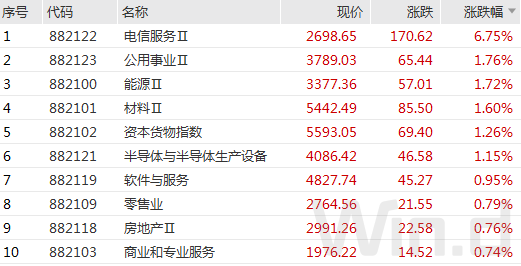
picture
From the perspective of the telecommunications service sector with the highest increase, China Telecom’s daily limit, China Unicom, China Mobile and other stocks also ranked among the top gainers. From the perspective of valuation, China Telecom and China Mobile’s price-earnings ratio is more than 10 times, and the dividend rate exceeds 5%.
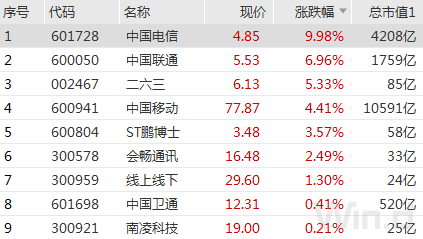
picture
From the perspective of falling sectors, the multi-finance, household and personal products, food and beverage, biopharmaceutical and other sectors made a slight correction.

picture
Due to the uncertainty of the long Spring Festival holiday, some subject stocks with large short-term gains have retreated one after another, and the popular stocks in the early stage such as Tongda Power, Taiyong Long March, and Yueling Shares collectively fell by the limit.
// The monthly inflow of capital from the north continues to hit new highs //
On January 20, Beijing’s net purchase of funds was 9.256 billion yuan, approaching 10 billion again. This year, the cumulative net purchase was 112.531 billion yuan. Although today is the last trading day before the Spring Festival holiday, the purchase volume is still at a relatively high level . Judging from the recent capital movement in the north, since the beginning of 2023, it has continuously maintained large net purchases, which can be described as a continuous increase in positions against the clock.

picture
Judging from the annual net purchases of Beijing funds, the net purchases have exceeded 110 billion yuan since the opening of the market in 2023. Not only has the net purchases in a single month continued to hit a new high since the opening of the Shanghai-Shenzhen-Hong Kong Stock Connect, but at the same time, if calculated on an annual basis, this year’s net purchases have exceeded 110 billion yuan. The purchase amount greatly exceeds the net purchase amount of 90 billion yuan for the whole year of 2022.
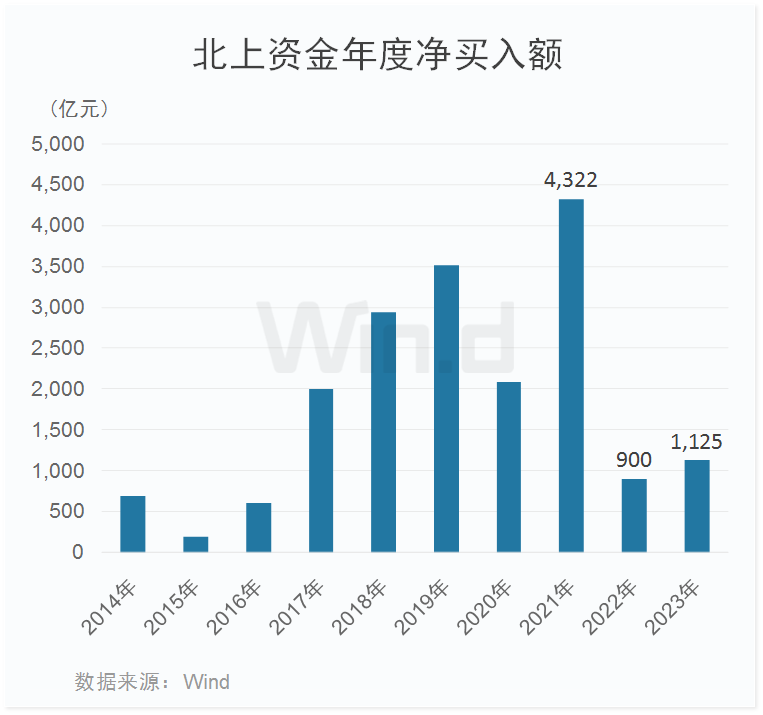
Judging from the shareholding changes of Beishang Capital from January 1st to January 19th, 44 companies had a net purchase amount of more than 500 million yuan, and Ningde Times increased its holdings by more than 8 billion yuan, with a net purchase of 19.0613 million shares, ranking first. First place; in addition, China Ping An, Kweichow Moutai, and Wuliangye have accumulated net purchases of more than 6 billion yuan; Longi Green Energy, China Merchants Bank, BOE A, CDFG, Zijin Mining, Oriental Fortune, BYD, Weil shares, Gree Electric, The net purchase amount of Wanhua Chemical, Aier Ophthalmology, Mindray Medical, Ping An Bank, Chalco, Yunnan Aluminum, and Sungrow also exceeded 1 billion yuan. Judging from the companies with the largest purchase amount, new energy, finance, and consumption are the focus of this round of capital increase by Beishang Capital.
(Note: Increase or decrease amount = increase or decrease amount * closing price on January 19)
The following are companies with a net purchase amount exceeding 500 million yuan:

picture
//A shares staged pre-holiday red envelope market//
On the last trading day of the Year of the Tiger (January 20), A-shares continued to rebound, and the Shanghai Composite Index closed up 0.76%, setting the index for the Year of the Tiger in the lunar calendar at 3264.81 points.

A-shares staged the “red envelope market” before the festival, and the Shanghai Composite Index welcomed the arrival of the Lunar Year of the Rabbit with “two consecutive suns”. In the last week of the Year of the Tiger, major A-share indexes rose across the board. The Shanghai Composite Index rose by 2.18%, the Shenzhen Component Index rose by 3.26%, the ChiNext Index rose by 3.72%, and the Kechuang 50 Index rose by 5.63%.

// The Year of the Rabbit is starting to catch up with the trend? //
A shares will resume normal trading from January 30. Combing the trend of A-shares after the Spring Festival in the past 20 years, it is found that there is a high probability that A-shares will continue to continue the “red envelope” market after the festival. The specific performance is: 5 trading days after the Spring Festival, the Shanghai Composite Index rose by an average of 1.72%, rising in 16 of the 20 years; 10 trading days after the Spring Festival, the Shanghai Composite Index rose by an average of 1.64%, rising in 14 of the 20 years; In the 30 trading days after the Spring Festival, the Shanghai Composite Index rose by an average of 1.83%, rising in 11 of the 20 years.
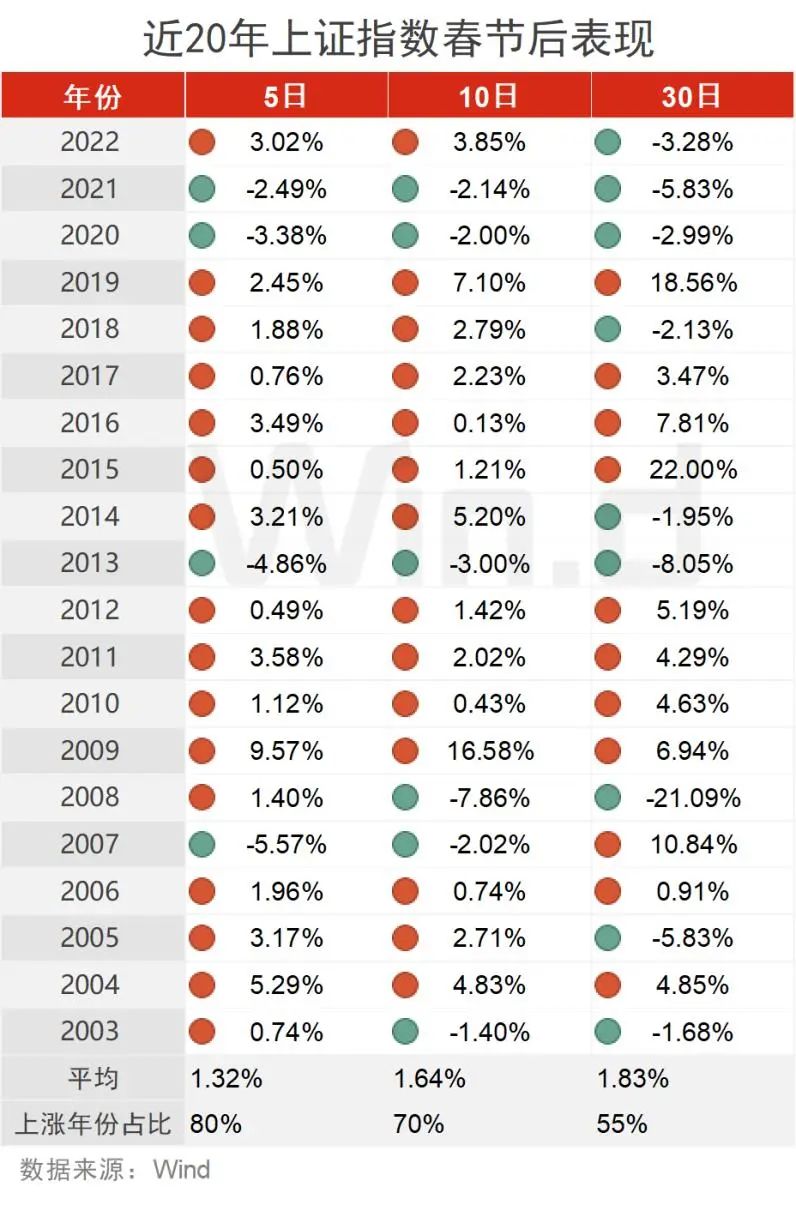
For the post-holiday market, the industry is generally optimistic. Some professionals suggest that under this expectation, investors can choose to hold shares for the festival, but they need to pay attention to position control.
CITIC Securities pointed out that the current A-shares are in the key long-term window of the year, and the high-frequency data verification and fundamental expectations form a positive feedback, thereby strengthening the consensus of investors to increase their allocation. Next, it is expected that after the rapid inflow of foreign capital, the rhythm will slow down, and domestic funds will also cover their positions, gradually forming a capital relay effect. Among them, the historical review shows that after the Spring Festival, the market is more likely to rise due to the concentrated inflow of foreign capital, and it is still a good time to increase positions.
The analysis of GF Securities pointed out that there is not much difference in holding shares during the holidays, and the key is how to allocate them. Judging from the information from the beginning of 2023 to the present, this year’s “spring turmoil” market has a friendly background, and the market is likely to be sustainable. First of all, the cost of funds for the new year is stable. Secondly, the economy has moved from freezing to recovery, real estate support policies have continued, and high-frequency data such as the operating rate of the production end and the passenger flow of the travel end have improved month-on-month after the epidemic. Finally, the RMB exchange rate has risen steadily, and the net inflow of northbound funds since January has exceeded 50 billion yuan, and the incremental funds have formed a long-term force. On the whole, the investment logic of this round of A-share value stocks is “buy expectations and sell reality”. When it is “weak reality”, the market looks for high prosperity.
// The most concerned areas of growth //
From the perspective of market history, among the main A-share indexes, the ChiNext Index performed the best in the first week after the Spring Festival. It has risen 15 times in 20 years, with a probability of 75% and an average increase of 1.88%.
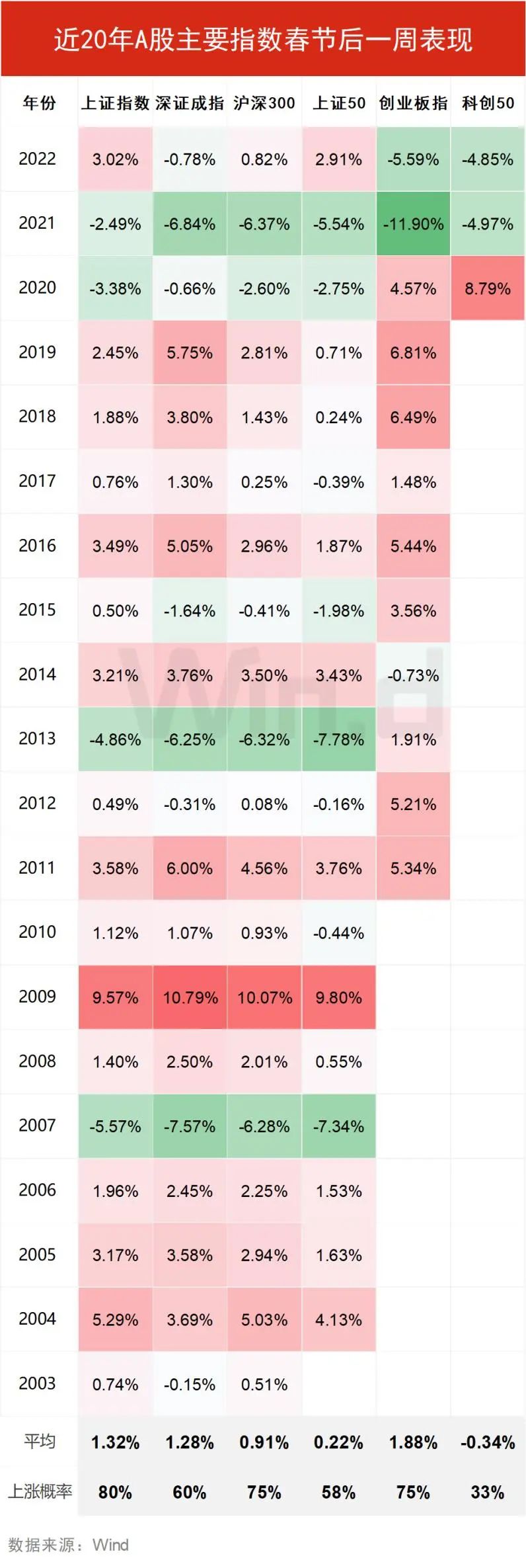
In terms of industries, in the week after the Spring Festival in the past 20 years, the average income of most industries has been positive. Among them, the average growth rate of environmental protection, agriculture, and comprehensive industries ranks among the top three, specifically 5.5%, 5%, and 4.4%; the financial industry generally performs poorly. Among them, the banking sector became the only industry with a negative average return.
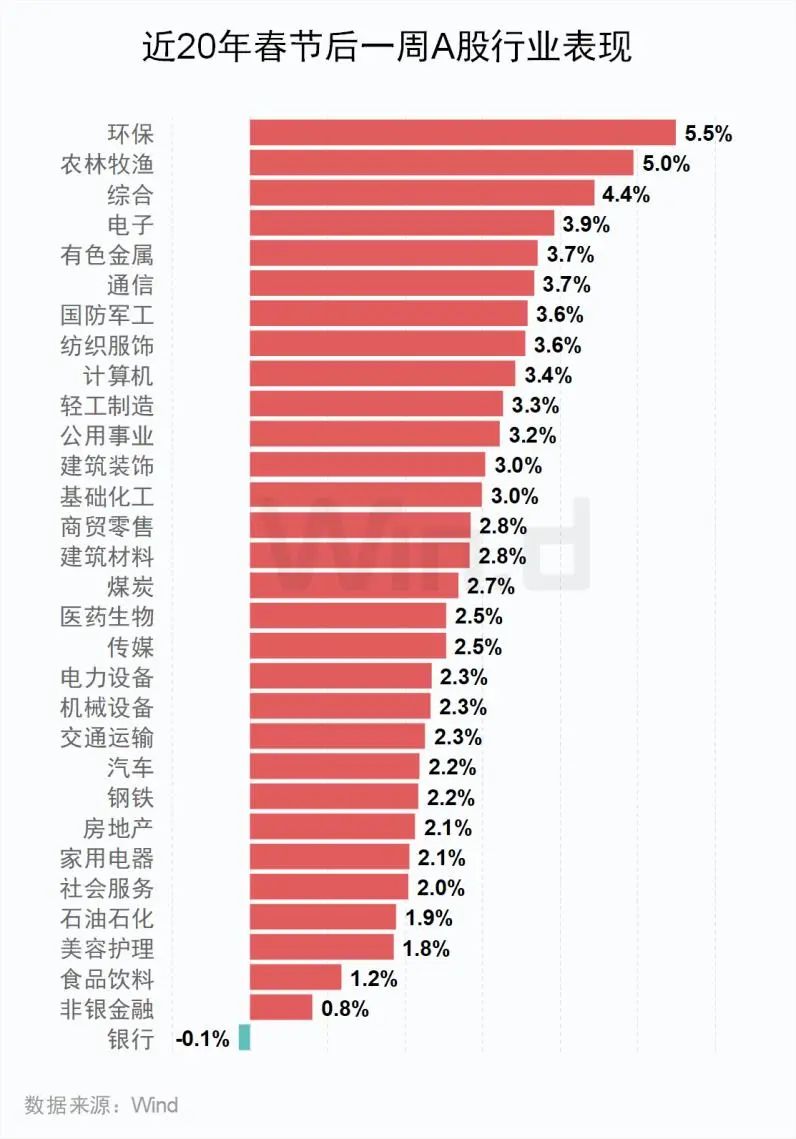
From an institutional point of view, the large consumer sector under the recovery expectation and the growth sector are the most promising market opportunities for brokerages.
The analysis of China Securities Securities pointed out that before and after the Spring Festival, there is usually a general rise in the market, and the performance of the growth sector is relatively strong after the Spring Festival. In terms of allocation, it is recommended that investors continue to grasp the long window and pay attention to the GEM, which has a more significant market winning rate after the festival. Among them, we can focus on the direction of significant improvement in fundamentals, such as photovoltaic downstream, green power, banking, medicine, etc., and the expected direction of policy stimulus can focus on the real estate chain, automobile, and Xinchuang industry chain.
Zhongtai Securities said that combined with the market performance around the Spring Festival in the past 10 years, the large consumer sector generally performed well before the Spring Festival. Technology sectors such as computers and military industry have performed relatively steadily around the Spring Festival in the past 10 years, and the investment value of the sector has become prominent in the short term. In addition, sectors such as electric power, UHV, and power grid transformation are currently in the bottom area, and the trading sentiment of the sector is low. In the future, under the catalysis of the steady growth policies, the sector may perform well, and it can be properly configured for defense. With the gradual normalization of the prevention and control of the new crown virus and the emergence of the government’s targeted stimulus effect, the market style may return to the undervalued blue chips of central enterprises in the second half of the year. Under the repeated impact of the epidemic, the pharmaceutical sector may become an important main line of the market in 2023.
Guotai Junan Securities believes that in 2023, China will enter a new cycle of demand recovery, asset return improvement, and profit expectations. In view of this, we are optimistic about the coupling of demand (endogenous repair) and supply (replenishment) and the gradual slowdown of overseas financial conditions. It is recommended to lay out the investment opportunities brought by the “New Year’s Market” superposition of New Year’s allocation. In terms of industry configuration, the direction with the biggest change and the least resistance is the pro-economic value stocks that are expected to be at the bottom and will benefit from the improvement of economic expectations and the recovery of the policy cycle. Recommended: finance (brokers, banks), consumption (food and beverage, hotel) , tourism/duty-free, aviation) and real estate chain (building materials, construction, furniture, home appliances).
